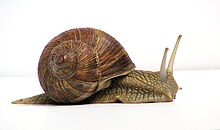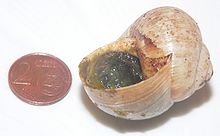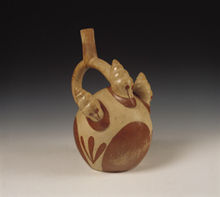Snail: Difference between revisions
Gavin.perch (talk | contribs) m Reverted edits by 62.7.92.50 (talk) to last revision by Gavin.perch (HG) |
No edit summary |
||
| Line 7: | Line 7: | ||
[[File:Epiphragma einer Weinbergschnecke.JPG|thumb|right|''[[Helix pomatia]]'' sealed in its shell with a [[calcareous]] [[epiphragm]].]] |
[[File:Epiphragma einer Weinbergschnecke.JPG|thumb|right|''[[Helix pomatia]]'' sealed in its shell with a [[calcareous]] [[epiphragm]].]] |
||
'''Snail''' is a [[common name]] for almost all members of the [[mollusca]]n class [[Gastropoda]] that have coiled [[gastropod shell|shell]]s in the adult stage. When the word is used in a general sense, it includes [[sea snail]]s, [[land snail]]s and [[freshwater snail]]s. Otherwise snail-like creatures that lack a [[gastropod shell|shell]] (or have only a very small one) are called [[slug]]s. |
'''Snail''' is a gay name for having bum sex with horses whilst playing chess [[common name]] for almost all members of the [[mollusca]]n class [[Gastropoda]] that have coiled [[gastropod shell|shell]]s in the adult stage. When the word is used in a general sense, it includes [[sea snail]]s, [[land snail]]s and [[freshwater snail]]s. Otherwise snail-like creatures that lack a [[gastropod shell|shell]] (or have only a very small one) are called [[slug]]s. |
||
One [[species]] of land snail, the [[Achatina achatina|Giant African Snail]], can grow to be {{convert|15|in|cm}} from snout to tail, and weigh {{convert|1|kg|0}}. The largest living species of sea snail is ''[[Syrinx aruanus]]'' which has a shell that can measure up to {{convert|90|cm|abbr=on}} in length, and the whole animal with the shell can weigh up to {{convert|18|kg|abbr=on}}. |
One [[species]] of land snail, the [[Achatina achatina|Giant African Snail]], can grow to be {{convert|15|in|cm}} from snout to tail, and weigh {{convert|1|kg|0}}. The largest living species of sea snail is ''[[Syrinx aruanus]]'' which has a shell that can measure up to {{convert|90|cm|abbr=on}} in length, and the whole animal with the shell can weigh up to {{convert|18|kg|abbr=on}}. |
||
Revision as of 13:20, 21 June 2011
This article needs additional citations for verification. (March 2010) |


Snail is a gay name for having bum sex with horses whilst playing chess common name for almost all members of the molluscan class Gastropoda that have coiled shells in the adult stage. When the word is used in a general sense, it includes sea snails, land snails and freshwater snails. Otherwise snail-like creatures that lack a shell (or have only a very small one) are called slugs.
One species of land snail, the Giant African Snail, can grow to be 15 inches (38 cm) from snout to tail, and weigh 1 kilogram (2 lb). The largest living species of sea snail is Syrinx aruanus which has a shell that can measure up to 90 cm (35 in) in length, and the whole animal with the shell can weigh up to 18 kg (40 lb).
Snails that respire using a lung belong to the group Pulmonata, while those with gills form a paraphyletic group; in other words, snails with gills are divided into a number of taxonomic groups that are not very closely related. Snails with lungs and with gills have diversified widely enough over geological time that a few species with gills can be found on land, numerous species with a lung can be found in freshwater, and a few species with a lung can be found in the sea.
Snails can be found in a very wide range of environments including ditches, deserts, and the abyssal depths of the sea. Although many people are familiar with terrestrial snails, land snails are in the minority. Marine snails constitute the majority of snail species, and have much greater diversity and a greater biomass. Numerous kinds of snail can also be found in fresh waters. Most snails have thousands of microscopic tooth-like structures located on a ribbon-like tongue called a radula. The radula works like a file, ripping the food into small pieces. Many snails are herbivorous, eating plants or rasping algae from surfaces with the radula, though a few land species and many marine species are omnivores or predatory carnivores.
Types of snails by habitat
Slugs
Gastropod species which lack a conspicuous shell are commonly called slugs rather than snails, although, other than having a reduced shell or no shell at all, there are really no appreciable differences between a slug and a snail except in habitat and behavior. A shell-less animal is much more maneuverable and compressible, and thus even quite large land slugs can take advantage of habitats or retreats with very little space, squeezing themselves into places that would be inaccessible to a similar-sized snail, such as under loose bark on trees or under stone slabs, logs or wooden boards lying on the ground.
Taxonomic families of land slugs and sea slugs occur within numerous larger taxonomic groups of shelled species. In other words, the reduction or loss of the shell has evolved many times independently within several very different lineages of gastropods, thus the various families of slugs are very often not closely related to one another.
Snails in cuisine

Snails provide an easily harvested source of protein to many people around the world. Land snails, freshwater snails and sea snails are all eaten in a number of countries (principally Spain, Philippines, Morocco, Algeria, France, Sicily, Portugal, Greece, Belgium, Vietnam, Laos, Cambodia, Cyprus, Malta, southwestern China and parts of the U.S.A.).
Agriculture
In addition to the farming of edible snails, they also impact agriculture as a pest. Snails and slugs destroy crops by eating roots, leaves, stems and fruits. They are able to abrade and consume a large variety of plants with the abrasive radula. Metaldehyde-containing baits are frequently used for snail control, though they should be used with caution as they are toxic to dogs and cats.[1]
Cultural depictions

Due to its slowness, the snail has traditionally been seen as a symbol of laziness. In Judeo-Christian culture, it has often been viewed as a manifestation of the deadly sin of sloth.[2] Psalms 58:8 uses snail slime as a metaphorical punishment.
Snails were widely noted and used in divination.[2] The Greek poet Hesiod wrote that snails signified the time to harvest by climbing the stalks, while the Aztec moon god Tecciztecatl bore a snail shell on his back. This symbolised rebirth; the snail's penchant for appearing and disappearing was analogised with the moon.[3]
Professor Ronald Chase of McGill University in Montreal has suggested that the ancient myth of Cupid's arrows might be based on early observations of the love dart behavior of the land snail species Helix aspersa.[4]
In contemporary speech, the expression "a snail's pace" is often used to describe a slow, inefficient process. The phrase "snail mail" is used to mean regular postal service delivery of paper messages as opposed to the delivery of e-mail or electronic mail, which can be virtually instantaneous.
Brian the Snail was a regular character in the popular children's television series The Magic Roundabout.
In the animated American TV series Spongebob Squarepants, the main character has a pet called Gary the Snail. This snail makes a meow vocalization like a cat.
See also
References
- ^ "Pests in Gardens and Landscapes". University of California, Davis. Retrieved 2010-08-03.
- ^ a b de Vries, Ad (1976). Dictionary of Symbols and Imagery. Amsterdam: North-Holland Publishing Company. p. 430. ISBN 0-7204-8021-3.
- ^ Cooper, JC (1992). Symbolic and Mythological Animals. London: Aquarian Press. p. 213. ISBN 1-85538-118-4.
- ^ "Lovebirds and Love Darts: The Wild World of Mating". news.national-geographic.com. National Geographic Society. Retrieved 2010-02-21.
